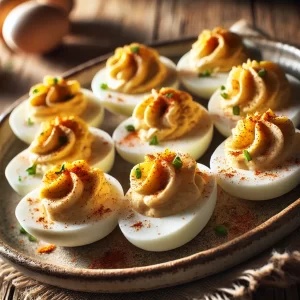Deviled eggs are a beloved appetizer that has graced tables around the world for centuries. Their creamy, tangy filling and elegant presentation make them a favorite at gatherings and celebrations. But where did this iconic dish originate, and how did it evolve into the version we know today?
In this post, we delve into the fascinating history of deviled eggs, exploring their ancient roots and tracing the development of the first recorded deviled egg recipe.
Ancient Origins: A Roman Delight
The origins of deviled eggs can be traced back to ancient Rome, where stuffed boiled eggs were seasoned with spices and served as a starter at the beginning of meals.
The Romans were known for their culinary innovations, and eggs were a popular ingredient due to their versatility and nutritional value. In the Roman Empire, it was common to serve boiled eggs seasoned with a variety of spicy, tangy, and savory ingredients such as vinegar, oil, and pepper.
The term “deviled” as it relates to food didn’t come into use until much later, but the Roman practice of spicing eggs was the precursor to what we now know as deviled eggs.
The Roman cookbook “Apicius,” compiled in the 4th or 5th century AD, contains a recipe that calls for boiling eggs, removing the yolks, and mixing them with ingredients like pepper, wine, broth, and oil, before stuffing the mixture back into the egg whites—a method remarkably similar to today’s deviled eggs.
The Term “Deviled” and Its Evolution
The term “deviled” began to be used in the 18th century in England to describe foods that were highly seasoned or spicy. By the 19th century, this term was commonly applied to a variety of dishes, including meats, spreads, and eggs, that were prepared with hot spices like mustard and pepper.
The first known recipe for deviled eggs as we would recognize them today appeared in a 13th-century Andalusian cookbook, which was later translated into other languages.
The recipe instructed cooks to boil eggs, remove the yolks, and mash them with a combination of spices and other ingredients before placing the mixture back into the egg whites.
By the 19th century, deviled eggs had become a popular dish in the United States, often made with mustard, mayonnaise, and a dash of paprika for added flavor and color. The dish was served at picnics, potlucks, and holiday gatherings, becoming a staple in American cuisine.
The First Recorded Deviled Egg Recipe
While the concept of deviled eggs had been around for centuries, the first recorded recipe that closely resembles the modern version of deviled eggs appeared in the 1896 edition of “The Boston Cooking-School Cook Book” by Fannie Farmer.
Farmer’s The Boston Cooking-School Cook Book was more than just a collection of recipes; it was an educational tool that empowered home cooks to approach their kitchens with confidence.
The cookbook quickly became a bestseller and remained in print for decades, influencing generations of cooks. Its impact was so profound that Fannie Farmer is often credited with shaping the modern American diet and cooking practices.
The inclusion of the “Stuffed Eggs” recipe in Farmer’s cookbook not only popularized the dish but also cemented its place in American cuisine. The recipe’s simplicity and adaptability made it a favorite at family gatherings, picnics, and holiday celebrations, and it continues to be a beloved dish in homes across the country.
Deviled Eggs: A Timeless Favorite
Today, deviled eggs are enjoyed in many different forms, from the traditional mustard and mayonnaise filling to more adventurous versions with ingredients like avocado, bacon, or sriracha. They are a versatile dish that can be customized to suit any palate, making them a popular choice for both casual and formal occasions.
The enduring appeal of deviled eggs lies in their simplicity and adaptability. Whether served at a family picnic, a holiday dinner, or a sophisticated cocktail party, deviled eggs offer a taste of history with every bite.
Deviled Eggs connects to ancient Roman feasts, medieval kitchens, and the classic American cookbooks that helped shape modern cuisine.

Original Deviled Egg Recipe
Ingredients
- 6 large eggs
- 2 tablespoons mayonnaise
- 1 teaspoon Dijon mustard
- 1 teaspoon white vinegar or lemon juice
- Salt and pepper to taste
- Paprika for garnish
- Optional: finely chopped chives or parsley for garnish
Instructions
Boil the Eggs:
- Place the eggs in a single layer in a saucepan and cover them with water. Bring the water to a boil over medium-high heat. Once boiling, remove the pan from heat, cover, and let the eggs sit for 10 minutes.
Prepare the Eggs:
- After 10 minutes, transfer the eggs to a bowl of ice water to cool. Once cooled, peel the eggs and cut them in half lengthwise.
Make the Filling:
- Gently remove the yolks from the egg halves and place them in a mixing bowl. Mash the yolks with a fork until smooth. Add the mayonnaise, mustard, vinegar or lemon juice, salt, and pepper, and mix until the filling is creamy.
Fill the Eggs:
- Spoon or pipe the yolk mixture back into the egg whites, filling each half generously. Sprinkle the tops with paprika and garnish with chopped chives or parsley if desired.
Serve:
- Arrange the deviled eggs on a serving platter and serve immediately, or refrigerate them until ready to serve.